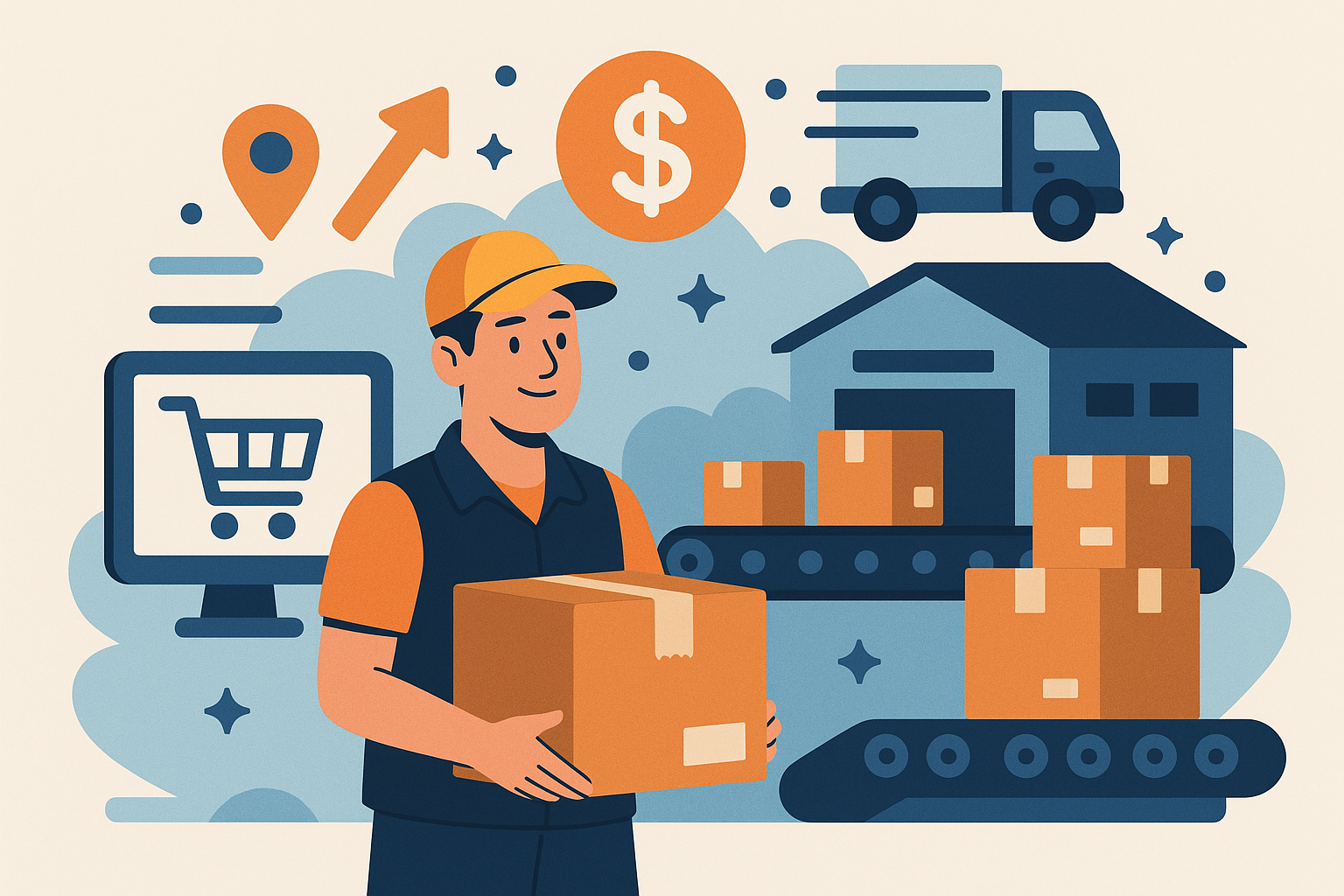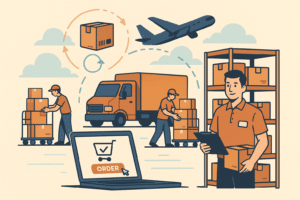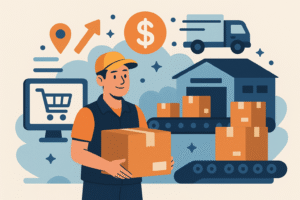Scaling an ecommerce business is exciting, but it comes with a hidden challenge that every growing brand eventually faces: fulfillment costs that rise faster than sales.
As order volumes increase, so do expenses tied to labor, storage, packaging, and carrier fees. Without the right systems in place, what once felt efficient can quickly become unsustainable.
That’s why understanding scaling and costs of fulfillment is essential for long-term growth.
Scaling fulfillment means expanding your ability to handle more orders efficiently, without sacrificing accuracy, delivery speed, or customer experience.
At the same time, fulfillment costs encompass every expense involved in getting an order to the customer: warehousing, labor, materials, shipping, software, and returns.
When these two factors, growth and cost, move out of balance, margins shrink and scalability stalls. The solution isn’t simply to spend less; it’s to optimize smarter.
That’s where ShipBuddies comes in.
As a technology-driven 3PL partner, ShipBuddies helps ecommerce brands grow faster with transparent pricing, automation, and scalable fulfillment services designed to reduce per-order costs as volume increases.
In simple terms: Scaling and costs of fulfillment describe how efficiently an ecommerce brand can expand its order-handling capacity while maintaining control of operational expenses.
With the right strategy and the right partner, scaling doesn’t have to mean higher costs—it can mean higher profitability.
Understanding Fulfillment Costs
Before you can optimize fulfillment, you need to understand what actually drives its cost. For most ecommerce brands, fulfillment expenses account for a significant portion of operational spend, often times as much as 15–25% of every order’s total cost.
Each dollar spent can typically be traced back to one of five key categories:
1. Storage and Warehousing
Storage costs include rent or space allocation, utilities, and equipment used to store inventory.
- Fixed costs: base rent, racking systems, and equipment.
- Variable costs: inventory turnover and seasonal storage spikes.
Brands often underestimate how quickly storage costs increase as product lines and order volumes expand.
2. Labor and Handling
Picking, packing, and labeling require time and skilled labor.
Labor is typically the most volatile expense in fulfillment, rising with:
- Increased order volume
- Seasonal surges (holiday demand)
- Inefficient warehouse layout or manual processes
Automation can reduce manual touchpoints and stabilize labor costs even as you scale.
3. Packaging and Materials
From boxes and dunnage to branded inserts, packaging adds both cost and opportunity.
Smart brands balance aesthetic value with practical efficiency, using right-sized boxes and sustainable materials to reduce DIM weight and waste.
4. Shipping and Carrier Costs
Carrier fees fluctuate based on delivery zones, weight, dimensions, and speed.
As you scale, shipping costs often rise unless you negotiate volume discounts or use a 3PL provider like ShipBuddies to optimize shipping, which pools carrier volume across many clients to unlock lower rates.
5. Software and Technology
Inventory systems, order management, and warehouse software are integral to efficiency.
Though these may seem like minor costs compared to storage or labor, the right software reduces errors, accelerates processing, and ultimately saves more than it costs.
Fixed vs. Variable Fulfillment Costs
| Cost Type | Description | Examples |
| Fixed Costs | Stay consistent regardless of volume | Rent, equipment, utilities |
| Variable Costs | Increase as order volume grows | Labor, packaging, carrier fees |
By identifying which costs scale directly with your volume, you can forecast future expenses more accurately and determine when it’s time to outsource 3PL services to a partner that offers scalability without unpredictable overhead.
Pro Tip: Calculate your Cost Per Order (CPO) by dividing total fulfillment costs by the number of orders processed in a given period.
Monitoring this metric over time reveals whether your fulfillment is truly scalable or increasingly inefficient.
The Challenges of Scaling Fulfillment
Scaling fulfillment is rarely a smooth, linear process. As ecommerce brands grow, they often discover that what worked for 100 orders a month begins to break down at 1,000 or 10,000.
Costs increase, workflows become more complex, and inefficiencies compound. Understanding these challenges early helps prevent operational growing pains that erode profitability.
1. Rising Labor and Staffing Pressure
As order volume increases, brands typically add more people to keep up.
But without automation or optimized workflows, labor costs scale faster than revenue.
Common issues include:
- Excessive manual picking and packing
- Inefficient order batching or routing
- Seasonal staffing shortages and overtime spikes
Automation tools, such as batch processing and barcode scanning, can significantly reduce this dependency on human labor.
2. Warehouse Capacity Limits
Warehouse space doesn’t expand automatically as your business does.
Growing inventory and product diversity often lead to:
- Overstocked shelves or poor organization
- Increased travel time per order
- Misplaced items and order errors
3. Rising Packaging and Material Costs
Larger order volumes mean more materials and higher expenses.
Without standardized packaging or bulk purchasing, brands face:
- Inconsistent material use
- Oversized packaging (higher DIM weight)
- Wasted time sourcing supplies
A fulfillment partner can streamline procurement and ensure consistent, cost-efficient packaging.
4. Unpredictable Carrier Costs
As more orders ship nationwide or internationally, carrier zones and rate structures change.
Brands scaling without volume-based contracts may see dramatic increases in per-order shipping costs.
ShipBuddies mitigates this by pooling carrier volume and passing on negotiated discounts, something small to mid-sized sellers can rarely secure independently.
5. Process Complexity and Data Visibility
Manual workflows make it hard to track true fulfillment performance.
As order flow scales, brands often lack visibility into:
- Real-time inventory levels
- Cost-per-order metrics
- Carrier performance analytics
Without this data, decision-making becomes reactive instead of strategic, leading to unnecessary expenses and customer frustration.
Key takeaway: Scaling fulfillment isn’t just about increasing capacity—it’s about maintaining efficiency and visibility as you grow.
Without a scalable system, the costs of labor, storage, and carrier logistics can quickly outpace your sales growth.
Strategies to Control Costs While Scaling
Scaling fulfillment doesn’t have to mean skyrocketing expenses.
By combining smart process design, automation, and the right partnerships, ecommerce brands can reduce their cost per order (CPO) even as volume grows.
Here’s how to scale efficiently while keeping costs in check:
1. Automate Repetitive Fulfillment Tasks
Manual work, like label printing, order routing, or carrier selection, eats up hours that could be spent on growth.
Automation software and integrations with ecommerce platforms (Shopify, Amazon, Etsy, and WooCommerce) can:
- Automatically import orders
- Generate accurate labels in seconds
- Choose the best carrier based on price and delivery speed
- Update tracking data in real time
ShipBuddies automates this entire process, removing human error, saving time, and ensuring every package moves through the most efficient route possible.
2. Optimize Warehouse Layout and Workflow
As order volume increases, even minor inefficiencies in layout can add up to thousands in wasted labor.
Focus on:
- Grouping top-selling SKUs near packing stations
- Creating one-way flow paths to prevent congestion
- Using barcode scanning to reduce picking errors
- Implementing order batching for similar items
A well-organized layout reduces travel time per order and keeps productivity high.
3. Use Predictive Analytics for Demand Forecasting
Overstocking ties up capital and space; understocking creates delays and missed sales.
Predictive analytics tools use sales history and seasonality to forecast demand accurately—allowing smarter purchasing and inventory allocation.
With this data-driven approach, brands can:
- Avoid storage surcharges
- Minimize obsolete inventory
- Prevent stock outs during demand spikes
4. Negotiate Better Carrier Rates Through Volume Partnerships
Carriers reward volume. But small and mid-sized brands can still access those rates by partnering with a 3PL provider that ships millions of packages annually.
Through ShipBuddies, businesses can benefit from carrier cost control with major carriers (UPS, USPS, FedEx, DHL), instantly reducing per-shipment costs.
5. Standardize Packaging to Reduce Waste
Standardizing box sizes and materials simplifies the packing process and reduces dimensional weight charges.
Many ShipBuddies clients save 5–10% on shipping costs simply by right-sizing packaging and eliminating unnecessary fillers.
Quick Recap: Cost-Control Framework
| Strategy | Primary Benefit |
| Automation | Lowers labor + error rates |
| Layout Optimization | Improves efficiency |
| Predictive Analytics | Prevents over/understock |
| Carrier Partnerships | Unlocks discounted rates |
| Standardized Packaging | Cuts DIM weight + waste |
Smart scaling is about efficiency, not expansion at any cost.
The right fulfillment systems ensure every new order contributes to profit—not just workload.
In-House vs. 3PL Fulfillment: Cost Comparison
As ecommerce businesses grow, one of the biggest strategic questions they face is whether to continue managing fulfillment in-house or outsource to a 3PL provider.
Both options come with unique advantages, and costs. The key is understanding which model supports scalability while protecting your profit margins.
In-House Fulfillment: Control with Rising Complexity
Running fulfillment internally gives brands total control over operations, but that control often comes at a high and growing cost.
Advantages:
- Direct oversight of inventory, staff, and packaging.
- Customizable workflows and branding.
- Flexibility for low order volumes or niche SKUs.
Challenges:
- High upfront costs (warehouse lease, equipment, staff).
- Variable labor and shipping costs that rise with volume.
- Requires constant investment in technology and space.
In-house fulfillment makes sense for startups or highly customized brands, but it becomes less cost-efficient once order volumes start to rise beyond a few hundred per month.
3PL Fulfillment: Scalable and Cost-Efficient Growth
Third-party logistics (3PL) providers like ShipBuddies specialize in scalable, transparent fulfillment.
They handle every step of the process, from receiving inventory to picking, packing, and shipping.
Advantages:
- Shared carrier volume = discounted shipping rates.
- Eliminates warehouse leases, hiring, and training costs.
- Integrated software with real-time visibility and analytics.
- Flexible pricing that scales with order volume.
Potential Considerations:
- Less direct control over day-to-day operations.
- Requires initial integration with your store and systems.
For most growing ecommerce brands, 3PL fulfillment delivers lower per-order costs, faster shipping, and greater scalability without the operational overhead of running your own warehouse.
Cost Comparison Table
| Cost Factor | In-House Fulfillment | 3PL Fulfillment (ShipBuddies) |
| Startup Costs | High: warehouse lease, equipment, staff | Minimal: pay per order or pallet |
| Labor & Staffing | Ongoing payroll + seasonal overtime | Included in fulfillment fees |
| Technology | Purchase, integrate, maintain | Built-in automation & analytics |
| Shipping Rates | Retail or negotiated at small scale | Volume-based discounts via 3PL network |
| Scalability | Limited by space & labor | Elastic: scales instantly with demand |
| Geographic Reach | Single or few locations | Nationwide via distributed network |
| Transparency | Internal tracking | Real-time dashboard reporting |
| Long-Term Costs | Increases with volume | Decreases per order with scale |
Hybrid Fulfillment: The Best of Both Worlds
Some brands use a hybrid model, keeping certain products or local orders in-house while outsourcing bulk or high-volume items to a 3PL.
This approach works well when:
- You want to maintain hands-on control over high-value SKUs.
- You need overflow capacity during peak seasons.
- You’re transitioning gradually from internal to outsourced fulfillment.
ShipBuddies supports hybrid setups seamlessly, integrating with your existing systems while handling additional volume as you grow.
Bottom line: In-house fulfillment gives control, but 3PL fulfillment delivers scalability, flexibility, and lower long-term costs.
For most growing ecommerce brands, outsourcing is the key to sustainable expansion.
When to Outsource Fulfillment
Knowing when to outsource your ecommerce order fulfillment can make the difference between a scalable, profitable operation and one that’s constantly struggling to keep up.
Many ecommerce brands hold onto in-house fulfillment too long, absorbing rising costs, slower delivery times, and increasing complexity that drains focus from growth. Recognizing the right time to make the shift is key to scaling efficiently.
1. Your Order Volume Has Outgrown Your Space or Team
A clear sign it’s time to outsource is when order growth starts exceeding your current capacity.
- Shelves are full.
- Staff is stretched thin.
- You’re constantly playing catch-up on shipments.
When you’re hitting physical and human resource limits, a 3PL partner like ShipBuddies provides instant access to additional space and labor, without forcing you to lease new warehouses or hire more staff.
2. You’re Spending Too Much Time Managing Operations
Fulfillment is essential, but it’s not where your business grows.
If managing inventory, packing, and shipping consumes more of your time than marketing or product development, outsourcing can help you refocus on strategy while experts handle the logistics.
ShipBuddies’ software integrates directly with ecommerce platforms, automatically syncing orders, generating labels, and tracking shipments, so your team can focus on growth instead of boxes.
3. You Need Better Technology and Data Visibility
Outdated systems make it nearly impossible to measure true fulfillment efficiency.
If you lack real-time insight into:
- Order accuracy
- Cost per order (CPO)
- Carrier performance
- Inventory forecasting
…then outsourcing to a technology-driven 3PL can close that gap instantly.
ShipBuddies provides real-time dashboards, reporting tools, and automation to help you monitor performance and costs in one place.
4. You Want to Scale Without the Overhead
Every new order shouldn’t require more staff or more square footage.
By outsourcing to a fulfillment partner, you gain elastic scalability, the ability to grow without expanding infrastructure.
This is especially valuable for brands with seasonal fluctuations or sudden viral demand spikes.
Decision Framework: Is It Time to Outsource?
| Indicator | You’re Ready to Outsource If… |
| Order Volume | You exceed 500–1,000 orders per month |
| Space | Your warehouse or garage is at full capacity |
| Labor | You’re hiring temporary staff regularly |
| Shipping Costs | Your average delivery cost keeps climbing |
| Focus | You’re spending more time managing fulfillment than growth |
| Visibility | You can’t easily track inventory or cost metrics |
If you check off two or more of these boxes, it’s time to start evaluating 3PL partners.
Pro Tip: Don’t wait for fulfillment to become a crisis before you outsource.
Transitioning proactively ensures smoother integration, better pricing, and uninterrupted service for your customers.
Measuring Fulfillment ROI and Efficiency
Once your fulfillment process is running smoothly, or once you’ve outsourced to a 3PL, it’s crucial to measure whether it’s actually working efficiently.
Fulfillment ROI (Return on Investment) goes beyond simply cutting costs; it evaluates how effectively your fulfillment operation supports growth, customer satisfaction, and profitability.
1. Why Measuring ROI Matters
Without clear performance metrics, you can’t tell whether your fulfillment operation is scalable or quietly draining profit.
Tracking ROI ensures:
- You identify where costs are creeping up.
- You measure the impact of automation and 3PL partnerships.
- You maintain control over scalability and customer experience.
When monitored consistently, ROI data helps you make proactive decisions instead of reactive corrections.
2. Core Metrics for Evaluating Fulfillment Performance
| Metric | Definition | Why It Matters |
| Cost Per Order (CPO) | Total fulfillment cost ÷ total orders | Reveals efficiency; should decrease as you scale. |
| Order Accuracy Rate | % of orders shipped correctly | Directly impacts customer satisfaction and returns. |
| On-Time Shipping Rate | % of orders shipped within promised timeframe | Measures reliability and consistency. |
| Throughput Efficiency | Orders processed per labor hour or per square foot | Indicates process efficiency and automation ROI. |
| Return Rate & Cost | % of orders returned + handling cost | Shows the hidden cost of poor fulfillment accuracy or product issues. |
Monitoring these KPIs gives a clear view of whether your fulfillment operations are supporting, or stalling, growth.
3. Tracking Financial ROI
To measure financial ROI, compare savings and performance gains against your total fulfillment expenses.
ROI Formula:
ROI = [(Total Savings + Added Revenue) – Fulfillment Costs] ÷ Fulfillment Costs × 100
For example:
If automation and 3PL integration reduce labor and shipping costs by $20,000 annually while increasing capacity by 25%, your ROI may exceed 150%.
4. Leverage Data Dashboards and Real-Time Analytics
Modern 3PLs like ShipBuddies provide real-time visibility into every fulfillment cost and performance metric.
From a single dashboard, you can:
- Track orders, inventory, and carrier performance.
- Identify process bottlenecks instantly.
- Compare CPO and throughput across time periods.
Having this data at your fingertips allows you to pivot strategies quickly and confidently.
5. Benchmarking Your Performance
Compare your data to industry averages:
| Metric | Industry Benchmark |
| Cost Per Order (CPO) | $8–$15 (varies by volume & product type) |
| Order Accuracy | 98–99% |
| On-Time Shipping | 97% or higher |
| Returns Processing Time | < 3 business days |
If your results fall below these benchmarks, your operation likely has room for optimization, especially in labor efficiency, automation, or carrier management.
Key Insight: Fulfillment ROI isn’t just about cost savings. It’s about ensuring every dollar you invest in logistics drives more sales, happier customers, and sustainable scalability.
Technology and Automation in Scalable Fulfillment
Scaling fulfillment efficiently isn’t just about adding more space or people. It is also about building smarter systems that do more with less.
Modern ecommerce logistics depend on automation and technology to keep operations agile, cost-effective, and error-free as volume grows.
1. The Role of Automation in Reducing Fulfillment Costs
Automation minimizes manual labor and human error, the two biggest cost drivers in fulfillment.
By integrating intelligent systems that handle repetitive tasks, you reduce handling time per order and increase accuracy at scale.
Examples of automation in action:
- Automated Order Routing: Assigns each order to the nearest warehouse or carrier automatically.
- Label & Documentation Automation: Generates shipping labels and customs forms instantly.
- Smart Inventory Replenishment: Reorders stock based on predictive demand models.
- Batch Picking & Barcode Scanning: Cuts pick times while ensuring order accuracy.
2. Technology That Powers Scalable Fulfillment
Successful scaling requires a connected tech stack that synchronizes data across every stage of the supply chain.
Key tools include:
- Warehouse Management Systems (WMS): Tracks inventory locations, stock levels, and movements in real time.
- Order Management Systems (OMS): Consolidates orders from multiple sales channels (Shopify, Amazon, Etsy, WooCommerce).
- Analytics Dashboards: Provide visibility into performance, cost per order, and shipping times.
- API Integrations: Connect fulfillment data directly with ecommerce and accounting platforms.
3. Predictive Intelligence for Smarter Scaling
Data-driven forecasting helps ecommerce brands stay ahead of growth rather than reacting to it.
By analyzing trends in order volume, customer location, and seasonality, predictive algorithms help you:
- Anticipate spikes in demand.
- Adjust inventory allocation proactively.
- Plan workforce and carrier needs before bottlenecks occur.
4. Real-Time Visibility and Decision Support
Transparency is critical as operations expand.
ShipBuddies’ technology gives businesses full visibility into every order, shipment, and cost component, so decision-makers can monitor:
- Current inventory levels across warehouses.
- Carrier performance metrics.
- Per-order profitability.
This level of control empowers brands to scale confidently, maintaining both speed and cost efficiency.
Bottom line: The future of fulfillment isn’t manual. It is intelligent.
By combining automation, predictive analytics, and centralized data systems, ecommerce brands can scale faster, cut costs, and deliver a better experience for customers.
Common Hidden Fulfillment Costs to Watch Out For
Even when fulfillment seems optimized on paper, many ecommerce brands still lose margin to hidden costs, the small, often-overlooked charges that accumulate quietly across thousands of orders.
Identifying and controlling these costs is essential to keeping your scaling strategy profitable.
1. Storage and Inventory Overages
Most fulfillment centers charge by the cubic foot or pallet, but when inventory lingers too long, long-term or overflow storage fees can add up fast.
Common triggers include:
- Overstocking due to inaccurate demand forecasting.
- Slow-moving SKUs occupying prime warehouse space.
- Seasonal stock held beyond its peak cycle.
Pro Tip: Use inventory aging reports to identify slow movers and adjust reordering frequency. ShipBuddies’ platform flags overstock automatically, helping you avoid unnecessary storage costs.
2. Packaging Markups
Custom packaging and branded inserts enhance customer experience, but they can quietly inflate costs when ordered inconsistently or from multiple vendors.
If your fulfillment partner doesn’t offer transparent materials pricing, packaging markups may go unnoticed.
ShipBuddies provides standardized, right-sized packaging options that lower DIM weight charges and eliminate surprise material fees.
3. Surcharges and Accessorial Fees
Carriers apply dozens of surcharges, some predictable, others not.
These include:
- Residential delivery surcharges
- Fuel adjustments
- Address correction fees
- Saturday delivery or oversize penalties
A 3PL partner helps prevent these costs by automatically verifying addresses, optimizing delivery routes, and negotiating volume-based rates that exclude or minimize common surcharges.
4. Returns and Reverse Logistics
Returns are inevitable, but inefficient handling can turn them into a profit drain.
Hidden costs often come from:
- Double handling (receiving + reprocessing).
- Return shipping fees.
- Restocking and repackaging expenses.
ShipBuddies integrates automated returns processing, allowing items to be inspected, restocked, or recycled with minimal manual labor.
5. Peak Season Fees
During high-demand periods, carriers and warehouses implement temporary surcharges or holiday pricing.
If you’re scaling quickly, these costs can spike dramatically without warning.
6. Manual Process Inefficiencies
The most expensive “hidden cost” isn’t always a fee. It’s wasted time.
Manual tasks like order entry, shipping label creation, and data reconciliation consume hours of labor that automation could eliminate entirely.
Automation isn’t just a convenience. It is also a cost-reduction strategy.
FAQs About Scaling and Fulfillment Costs
To wrap up this topic, here are answers to some of the most common questions ecommerce brands ask when evaluating how to scale their fulfillment operations efficiently and cost-effectively.
1. What are the main costs of fulfillment?
Fulfillment costs include storage, labor, packaging, carrier fees, software, and returns processing.
These expenses make up your cost per order (CPO), a critical metric that reveals how efficiently your operation runs.
2. Why do fulfillment costs increase as you scale?
As order volume grows, costs often rise because of inefficient workflows, labor dependence, and limited capacity.
Without automation or a multi-location strategy, brands end up spending more per order even as they sell more.
Partnering with a 3PL like ShipBuddies prevents this by using automation and distributed fulfillment to reduce per-order costs as volume increases.
3. How can ecommerce brands reduce fulfillment costs?
You can lower costs by:
- Automating picking, packing, and label generation.
- Standardizing packaging and reducing DIM weight.
- Negotiating volume-based carrier discounts through a 3PL.
- Using data analytics to forecast demand and optimize inventory levels.
4. When should a brand outsource fulfillment?
Most ecommerce brands benefit from outsourcing when they consistently exceed 500–1,000 orders per month or spend more time managing logistics than growing their business.
At that stage, outsourcing saves time, reduces overhead, and unlocks access to enterprise-level shipping rates.
5. What’s the difference between in-house and 3PL fulfillment costs?
In-house fulfillment requires paying for space, staff, and software, whether you’re busy or not.
3PL fulfillment turns those fixed costs into variable costs, meaning you only pay for what you use.
With ShipBuddies, brands gain elastic scalability: the ability to grow or contract effortlessly while maintaining cost control.
6. How can I measure the ROI of my fulfillment operations?
Use metrics like Cost Per Order (CPO), accuracy rate, and throughput efficiency.
If your CPO decreases and your customer satisfaction increases as you scale, your fulfillment ROI is positive.
7. Are there hidden fulfillment costs I should watch for?
Yes. Storage overages, packaging markups, peak season surcharges, and return handling fees often go unnoticed.
Choose a fulfillment partner that provides transparent, itemized pricing and performance tracking.
ShipBuddies is built on that model, no surprises, no hidden fees.
How ShipBuddies Scales with You
Scaling your fulfillment operation shouldn’t mean sacrificing profit, control, or peace of mind.
That’s exactly why ShipBuddies exists, to help ecommerce brands of every size grow faster, smarter, and more efficiently.
1. Scalable Fulfillment Without the Growing Pains
Whether you’re shipping 50 or 5,000 orders a day, ShipBuddies adapts to your needs instantly.
Our network of fulfillment centers, automation systems, and carrier integrations ensures you can expand without adding staff, space, or stress.
What that means for you:
- No warehouse leases or staffing headaches.
- Faster shipping with distributed inventory.
- Scalable pricing that adjusts with your order volume.
You focus on selling. We will handle the logistics.
2. Transparent Pricing and Predictable Costs
Hidden fees kill profitability. ShipBuddies’ pricing model is built on total transparency. You will always know exactly what you’re paying for.
Included with every partnership:
- Clear per-order pricing (no storage surprises).
- Discounted carrier rates through shared network volume.
- Real-time cost tracking and reporting dashboards.
This allows you to forecast your expenses accurately and make confident growth decisions.
3. Technology That Powers Efficiency
Our fulfillment platform combines automation, analytics, and predictive intelligence to keep your operations running at peak efficiency:
- Real-time order syncing from Shopify, Amazon, and other marketplaces.
- Automated carrier selection to minimize delivery costs.
- Fulfillment dashboards that track accuracy, speed, and cost per order.
Every process, from order import to shipment confirmation, is handled by smart systems that reduce time, labor, and cost.
4. A True Growth Partner
ShipBuddies isn’t just a 3PL. It’s a logistics partner invested in your success.
We work closely with ecommerce brands to refine operations, reduce overhead, and create scalable systems that support long-term growth.
Our promise:
As your business scales, your fulfillment should scale with it, without friction, without hidden costs, and without limits.
Get Started Today
If your ecommerce business is ready to:
- Cut fulfillment costs
- Ship faster and smarter
- Eliminate operational bottlenecks
Then it’s time to connect with ShipBuddies.







